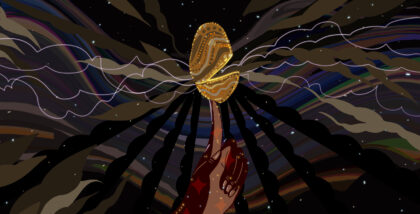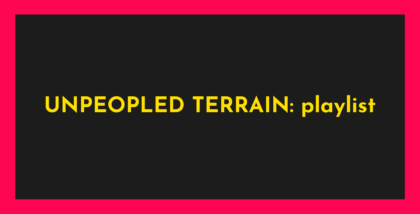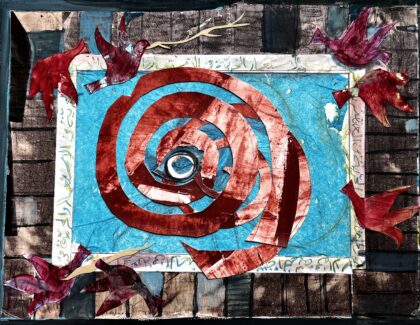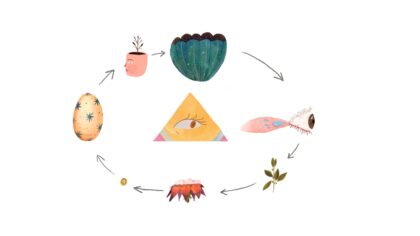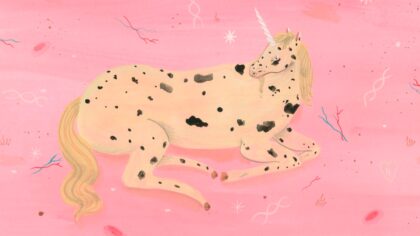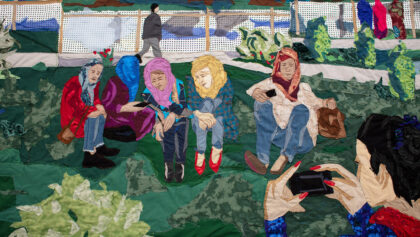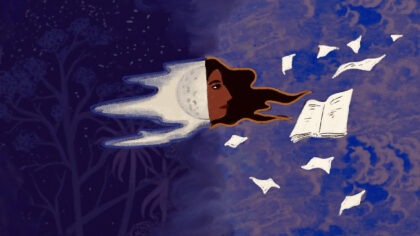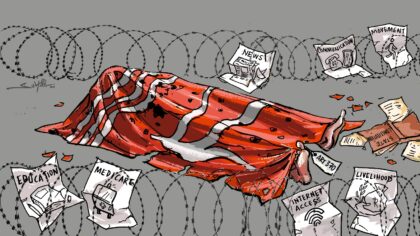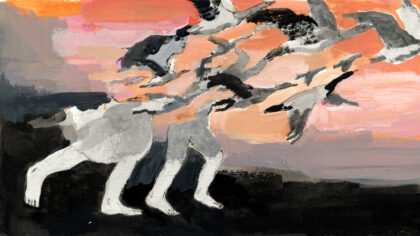 Art by Sab Meynert
Art by Sab Meynert
In his younger days, Don Jesús Smith Kantule would leave his home on Usdup island early in the morning and head out to the water, on the same schedule as most men in the Indigenous territory of Guna Yala, a narrow strip of the Panamanian coast and 365 islands speckled along the adjacent waters of the Caribbean. He would climb into his cayuco—a thin hand-carved dugout canoe—and then row for an hour until he reached the wiry mangroves at the edge of the Guna’s mainland forest.
As the sun peeked over the mountains, Don Jesús would zigzag his way into an opening in the trees. Armed with his machete, he’d walk past creeks and the tall canopies of velvet trees and round-crowned leopardwoods until he reached the small plot where he grew food for his family: plantains, coconuts, bananas, yams, and cassava roots. Guna men typically work the same plot alone or collectively for five to six years, and then let it sit fallow for the next 30. They then move onto another piece of forest nearby, clearing it and producing there until it is time to move on again, and let the forest recover.
Don Jesús would have looked around for any evidence of jaguars, tapirs, or wild boars crossing through his plot; he grew more produce than his family typically needed so he could share with forest creatures, but he would also hunt those animals if the need ever arose. Finally, he would get to work. He’d clear out some of the brush, careful not to cut down the small medicinal plants that grew under the shade of the tallest trees. He’d harvest the ripest fruits and vegetables and gather them in a big pile. Then he’d take his haul down the mountain and load it into his cayuco to make the journey back home, just in time for lunch with his family.
“Since the Guna people have existed,” he told me when I visited him several years ago, “they have been one with nature. And nature, in turn, has ruled our survival.” Don Jesús is 85 years old now and too weak to row out to the forest anymore. His grown children and grandchildren have left Guna Yala for Panama City, just like so many young people seeking education and jobs, so he gets his food from a local market and not directly from the forest. But he still spends his days thinking about that mainland forest: what it represents, how to keep it standing, and how to share what he knows as a local chronicler with anyone who will listen. In his casita, he’ll sit behind his wooden desk, facing the door that opens to the street so he can spot people as they walk past. “Hey!” he’ll yell out, and then start telling them stories, or showing them his notes and illustrations of plants and traditions. Written on a pad of lined paper, they are an amateur encyclopedia of Guna life.

I had come to Usdup to talk to Don Jesús about Paduala, the Guna creation myth about an enormous coconut tree that fell on the Caribbean; as it touched the water, its long leaves turned into a fan of islands. The Guna, he tells me, believe the Earth was deserted until their god Bab Tummat created the first tree named Wago, a deeply rooted, magical being with a soul, much like a human. Wago was the “father of all trees,” and from him came all the forests. Before a tree is cut for building materials or to make room for planting, men must sing to Wago, asking for his permission.
Don Jesús gets his eminence from his grandfather, Nele Kantule, an adivino, or prophet, who supposedly could foresee a range of events, from weather to politics. From the time he was ten years old, he began to learn directly from the spirits; he could predict when it was going to rain, and when the winds were about to blow so hard they would cause damage to the islands. He once had a vision of a Guna Yala free from Panama’s occupying rule, and in 1925, when he was 57, Kantule led the San Blas Rebellion that would make Guna Yala an independent and sovereign Indigenous territory within that Central American country—among the first of its kind in the Western Hemisphere.
It is thanks to this legacy of self-determination, this stubborn connection to ancestral lands and to Wago and Bab Tummat, that Guna Yala still has one of the best preserved old-growth tropical rainforests in the region. Almost a decade since that meeting with Nele Kantule’s grandson, I can still zoom into the satellite image of their territory online—roughly 925 square miles along the northeastern coast, near the border with Colombia—where a continuous band of light green stands out in a landscape pockmarked with development.
*
There is a twist to the Guna creation myth, one I heard from other wise men across Guna Yala. Wago would eventually abandon his role as forest protector and become cocky, believing himself greater than the god who created him. Bab Tummat had to send Wago back to the fourth level of the universe, where he remains. This story is told to children as a cautionary tale, so they learn that they cannot do as they please in the forests. The Guna say that finding a balance with the natural world is what distinguishes them as a people.
When I first visited in 2009, the Guna’s approach to conservation and their stretch of healthy forest were drawing the attention of the backers of a global program designed to fight climate change. The program is called REDD+ (Reducing Emissions from Deforestation and Degradation), a UN and World Bank-supported climate change mitigation scheme. The program aims to reduce forest loss worldwide by paying developing countries to set aside carbon-absorbing tropical forests in order to offset pollution by (mostly) industrialized ones.
The financing derived from REDD+, an estimated $5.2 billion since 2008, was supposed to be more attractive than any profits that would be made through illegal logging, mining or large-scale infrastructure projects. The thinking went that countries with high deforestation rates, all of them in the Global South, would be incentivized to scale up forest conservation.
But from its very inception, REDD+ would prove contentious, as it relied on the power of the carbon market to mitigate climate change and took advantage of an unequal economic relationship between developing and industrialized countries.
In April 2007, representatives from the Panamanian government met with World Bank officials in Berlin to hammer out a lucrative carbon offset deal that involved Guna land. As long as tropical forests weren’t felled in Panama, $12 million from REDD+ funders would come to the Panamanian government. But first, officials needed to secure approval and participation from all the people living in those forested areas. Unlike Panama’s other Indigenous peoples, according to the constitution, the Guna have total control over their own land.
The Guna had not been included in that Berlin meeting between the World Bank and the Panamanian government, but they were soon the targets of a charm offensive. Between 2008 and 2013, a variety of players gathered under thatched-roof huts across Guna Yala’s islands to discuss REDD+: international NGOs invested in a possible “yes” vote, small nonprofits skeptical of the plan, and, of course, The World Bank, which initially spent $250,000 to woo the Guna and Panama’s other Indigenous communities into signing on to REDD+.
“Who does nature belong to?” asked one of the sailas, traditional elders, during one of the many information workshops on REDD+. “The answer is, us Guna. That is why they must respect us and therefore consult us about whether we want the program.”
The elders also wanted to know: Did the Guna own not just the land and the trees, but also the trees’ carbon rights? Once the carbon credits were traded, where would their value in cash end up? But most notably: Why should the Guna sign up to a program to avoid deforestation when they’d been doing that for millennia without financial incentives?

The prospect of having to set any of their land aside was difficult for the Guna to grasp given their hard-won sovereignty, coupled with the fact that they don’t believe in rigid no-cutting policies. As long as they stick to their methods of incremental, communal farming, and long periods of re-generation, they believe that their management will keep the forest in good condition.
Approximately 30 million acres of forests are cut down across the globe every year. So it is almost miraculous that we can find rich ecosystems like the Guna’s, still thriving after generations. The forest has a great social and cultural value for them—so great, in fact, that they cannot put a price on it in the way modern conservation strategies do. Doing so would betray Bab Tummat.
The Guna’s highest authority, the Guna General Congress, delayed a vote on the scheme at least three times. But in the end, in June 2013, they voted NO, sending a strong message against market-based climate change mitigation solutions and becoming one of the few Indigenous peoples around the world to stand against REDD+ and its promise of cash.
*
As the first truly global climate scheme of its kind, REDD+ paved the way for countries to work side-by-side to reduce emissions. But its one-size-fits-all approach to forest conservation has not slowed deforestation, nor has it substantially helped to support biodiversity. As of May 2018, some 350 REDD+ projects, in 53 countries, cover an area of about 43 million hectares (roughly the size of Morocco). About the same number of hectares of tropical rainforest was destroyed in the Amazon between 2004 to 2017, while REDD+ was being implemented in parts of the region. It seems clear that the effective conservation of our forests may require a different approach, one that is less top-down and more collaborative.
Since their rejection of REDD+, the Guna have been hosting meetings critiquing what they call “false solutions” to climate change, and advocating instead for honoring various cultural traditions of sustainability. They have become a model of local conservation, and their success highlights Indigenous sovereignty as a key factor in natural resource management.
I attended one of their first gatherings in Usdup in 2014. Don Jesús was tasked with the logistics and he reveled in his new role, running around and making endless calls on his cellphone to try to secure ice, a motorboat for field trips, and a generator for four days of PowerPoint presentations. A number of participants came from South America, sub-Saharan Africa, and Southeast Asia to learn about the Guna approach.
“I’ve come here to learn about REDD+ so I can tell my community about what works and what doesn’t,” Alicia Cahuilla, a Waoraní leader from Ecuador, told me. She sat on top of an old tree trunk in the Guna mainland forest, taking a break from a group hike to see traditional agricultural plots. “If our forests end up under REDD+, who’s to say our children and their children will be able to live there?” Alicia has since been at the forefront of fighting oil exploitation at Yasuní National Park, which is adjacent to Waoraní ancestral lands. She has also organized fellow Waoraní to stop working with US conservation nonprofits eager to start privately-funded carbon offset partnerships. Like the Guna, they have too many unanswered questions about what Western conservationists have in store for them.
These conferences target young Indigenous eco-activists and have continued annually. More than 400 people—most of them from Central America—have graduated from Guna Yala’s home-grown trainings, an alternative to the World Climate Summits that bring together high-level representatives from public and private sectors in the industrialized world. Instead, Guna gatherings happen under thatched-roof huts and alongside the sailas who advocate for native knowledge, and honoring the free, prior, and informed consent of Indigenous people.
*
As the Guna and many other Indigenous communities demonstrate, tackling climate change will indeed require a range of interventions—some possibly as big as REDD+—although hopefully more effective—that can work alongside local conservation-by-default practices. But maybe this moment is as good a time as any to question whether solutions rooted in capitalism just prime us to consume more and more. We keep feeding the beast that has brought us to where we are now—on the precipice of disaster. Maybe there’s a middle way that requires the industrialized world to humbly accept its place in the cosmos, and scale back.
The urbanized West has mastered turning nature into profit, transforming what is sacred for many into a money-making Next Big Thing for the few. Profit drives pilfering everywhere, particularly in the tropical rainforests of the developing world, which colonizers like to see as unpeopled and therefore untouched, free for the taking.
But there is no such thing as a virgin forest devoid of humans: Indigenous peoples around the globe have called such forests home for thousands of years, coexisting with other species, harvesting fruits and medicines, and using wood sustainably long before and after the colonial powers came along. The Guna know that forests are much more than carbon sinks; for them, ecosystems are intricate networks of beings with souls.
Almost two decades since my first visit, I think back to the feeling of being in Guna Yala—how in the late afternoons, when the sun begins to set and the cool breeze kicks in, the coconut palm leaves rustle gently above your head to an almost numbing effect, helping you forget all that ails our world.
When I asked about the forest’s natural medicines, all Don Jesús would tell me was: “They are used in rituals that are full of mystery.” He’d go on to describe how a handful of cacao seeds can be boiled in a clay pot and the vapor can be inhaled to cure ailments. What sorts of ailments? “That’s the mystery,” he insisted, with a smile. I’ve realized that when it comes to the Guna eco-spiritual worldview, to Wago and why he strayed from his mandate as the father of all trees, there is only so much I can comprehend, only so much Don Jesús is willing to share with non-Guna outsiders like myself. He reserves the full explanations for the Guna who still live on the islands and the ones that sometimes come back from the city on holidays, determined to keep their traditions alive.
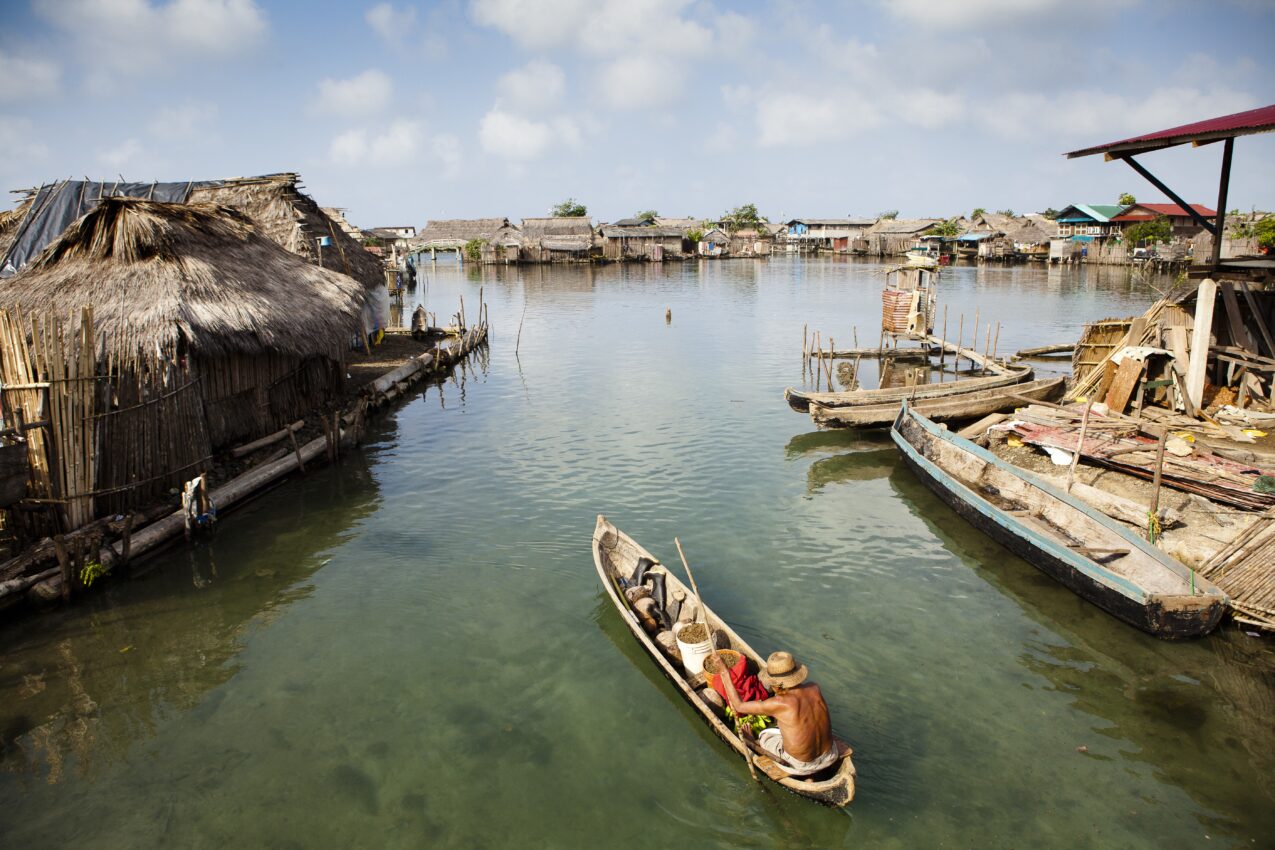
For many Indigenous peoples, tropical forests represent a key, irreplaceable link between the sky and the earth, past and the present, what’s tangible and of this world and what’s not. Meanwhile, the money-driven world seems to lack the capacity to embrace this true value of forests, and for that matter, of life. Even as the connection between the neoliberal capitalist system and the climate crisis becomes a part of public discourse, the West seems incapable of finding ways to save forests that don’t rely on monetary incentives.
As saila Tomás de León told me some years ago: “Humanity is always making up new problems and following that up with solutions.” Except the solutions we’re dreaming up now don’t seem to make up for the destruction. We are already deep into a crisis that our business-as-usual ways cannot fix.
During my last visit to Usdup, I spent clear, starry nights under the big straw-roofed hut where villagers gathered to listen to their sailas sing pab’igalas, songs about the islands, the ocean, and the beings that call both home. Coming to the communal hut at night has always been a lesson in history and civics and preserving cultural identity—an important feature of Guna life.
That night, Tomás de León recounted a tale. Every year, he sang, between October and November, the seagulls migrate away from Guna Yala. This is known as kiginani, and it is a cycle that always coincides with the rise of the tides and with the time of year when all the beasts in the forests come down to eat and drink near the shore and the riverbanks.
The room fell silent. I looked around, noticing how the rest of the audience—young and old, male and female—listened to the saila with their eyes closed. I too closed mine as I imagined the seagulls and the animals gathering by the water.
“This is happening now, and it will always happen,” Tomás de León sang.
In the distance, I could hear the wind blowing gently against the coconut palm trees. On the edge of a rising sea, the Guna are nonetheless hopeful. They see their rejection of REDD+ as the righteous symbol of an alternative future that’s still within reach as long as they can keep making allies, and as long as Wago can return to his roots, recalling his original vocation as father of the forest.





